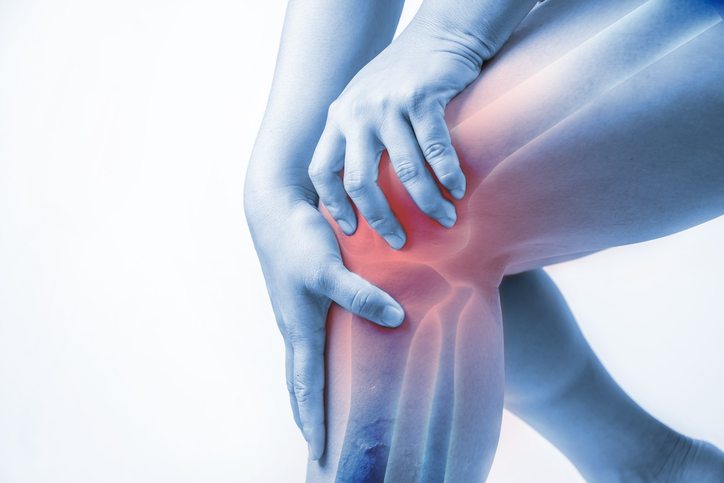When a baby cries, he’s trying to tell you something. Babies lack the language skills to say, “I’m hungry” or “I need changing” or “I am in pain.” And if the baby is in pain, he can’t describe that to you.
Your body is not too different. The body’s only means of communicating with you is through feelings, the most common of which is pain. It has to get your attention and “tell” you what’s wrong, and where.
Those signals can be miscommunicated frequently, either by your body’s outgoing message or your incoming understanding of what’s happening.
The soft tissues, connective tissues, nerves, blood vessels are all intertwined networks of supply, demand, communication, response, action, and nurturing. Sometimes, these wires get a little crossed.
In fact, there have been thousands of studies of these “misfires” so that patterns of behavior have been mapped. When one area of the body is injured or in pain, but you feel it in a different area, this is called referred pain.
With the knee in particular, there are specific areas of injury and tightness elsewhere that cause referred pain in the knee. Why? Because you pay attention to knee pain. You “listen” when your knee hurts. But really it’s because of muscle spasm, nerve entrapment, and cellular dysfunction caused by trauma, injury, and lifelong habits, stressed, illness, poor diet, sleep disorders, etc.
What causes referred pain?
Compression of an inflamed nerve anywhere along its path causes it to secrete its specific hormone. Pressure on an inflamed sensory nerve cell can cause the brain to experience pain. This is called nociception.
If a motor nerve is compressed, the hormone that is secreted causes the muscle to contract in a protective muscle spasm. Prolonged spasm in the muscle can lead to more dysfunction in the nerves and muscles including atrophy and loss of normal neurological functions.
Let’s review possible causes of knee pain that need to be excluded before you pursue aggressive treatment for an injury that may or may not be causing your symptoms.
Poorly fitting shoes
Yes, this source with its “cure” is the simplest, most cost effective, and easiest to test. Shoes that provide support where you don’t need it, that over pronate your feet, that are so old that they provide no cushion need to be looked into.
Sometimes orthotics or other special fit cushions for your feet, which are designed to retrain your foot musculature to improve your gait and foot strike need to be examined; if the foot has changed (which is the goal), then these supportive devices need to be adjusted.
In fact, your ill-fitting and worn out shoes can cause more than just foot and knee pain. They can cause hip and low back pain, as well as shin splints, stress fractures, plantar fasciitis, and other painful ailments.
Iliotibial band friction syndrome
Iliotibial band (or “IT band”) is the band of fascia (connective tissue) that runs alongside the quadriceps musculature on the outside of the leg. It begins at the iliac crest and ends at the tibial tuberosity, which is the protuberance under the knee (at the top of the tibia).
Along the boundary of the vastus lateralis and fascia, tightness and trigger points can radiate pain down to the sides of the knee. This referred pain is frequently mistaken for meniscus pain.
IT band friction syndrome is specifically caused by excessive heel and foot pronation, bow legging, lack of stretching and medial rotation of the lower leg.
Symptoms may include lateral knee pain, pain radiating down toward the top of the tibia (lower leg), and pain worsening with walking or running but easing with rest.
Basically all quadriceps and hamstrings muscles refer pain to the knee. Sartorius is particularly nasty, crossing from the lateral hip to the medial knee. Therefore, you can have pain in your medial knee coming from the front lateral aspect of your thigh. Gastrocnemius (calf muscle) sends pain to the posterior (back) knee.
Piriformis Syndrome
The sciatic nerve, which is huge, about the size of your small finger, runs through the gluteal region between the piriformis muscle and superior gemellus muscle. This syndrome mimics true sciatica, causing pain down the posterior aspect of the thigh, into the knee, and down toward the foot. It is caused by a pinching of the nerve between these muscles. It occurs more frequently in women than men, and especially in active runners and walkers.
The symptoms can cause a shortness of the extremity, lateral rotation, and decreased range of motion.
This is also referred to pseudo-sciatica or false sciatica and, combined with referred pain from arthritis and other joints, is more common than true sciatica.
True sciatica has an origin in the lumbar spine. As described above, the sciatic nerve is large. In fact, it is the largest nerve in the body. It originates in the nerve roots of L4-S3 (lumbar vertebra 4 through sacral vertebra 3) and extends down through the gluteal muscle and sends nerve endings down into the lower leg.
Many people think that sciatica is caused by disk herniation. However, any kind of irritation or inflammation of the sciatic nerve can produce symptoms of sciatica, not just a disk herniation. This includes irritation of the nerve from adjacent bone, tumors, muscle, internal bleeding, infections, and injury.
Sciatica from the L4 nerve root causes pain and/or numbness to the medial lower leg and foot. It may include weakness that prevents you from moving your foot upwards.
Sciatica from the L5 nerve root includes weakness in extending the big toe and ankle, referred to foot drop. Foot pain and numbness occurs at the top of the foot, especially between the big and second toes.
Sciatica from the S1 nerve root produces pain and/or numbness in the lateral (outer) foot and weakness that makes it difficult to walk on tiptoes.
Pressure on the sacral nerve roots from sacroiliac joint dysfunction produces pain that is described as a generalized deep ache in the leg; whereas, pain from the higher nerve roots produce pain in a defined geographic area.
Synopsis
Before running to a surgeon because you knee hurts, look at your shoes, your posture, how you walk, and what you eat. Consult a physical therapist who can examine your movement patterns and discern imbalances in your muscles. Correlate any of your symptoms with how you live and move, with radiographic images, and sound medical advice. Seek regenerative medicine for care that allows your body to heal itself, when cells need a helping hand to get the process started.
GIOSTAR Chicago provides regenerative cell-based therapy for knee injuries and many other conditions. To learn more about treatment options, please contact us, or call us at 1-844-466-7827.



